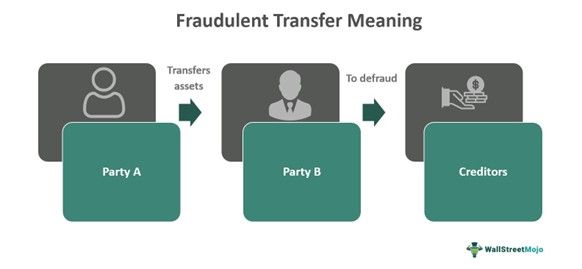Table of Contents
What Is A Fraudulent Transfer?
A fraudulent transfer is done to avoid debt by transferring assets to someone else, typically a family member, corporation, or trust. It is fraud if done with the intention to deceive creditors, made with insufficient consideration, or became insolvent prior to or as a result of the transfer.

The consequences of the fraud, whether actual or constructive fraudulent transfer, are the same. Creditors and bankruptcy trustees may sue the transferee. If fraud is proven, the court may declare the transfer void and require restoring the transferred funds or property. The court may issue a monetary judgment against the transferee equal to the transferred asset's value.
Key Takeaways
- A fraudulent transfer is a transaction where a debtor transfers property to undermine creditors' rights, potentially leading to loss.
- The Uniform Fraudulent Transfer Act identifies transfers as fraudulent if the debtor intends to defraud creditors, receives no reasonable value, and meets certain financial conditions.
- Factors like insider involvement, asset retention, concealment, insolvency, threat involvement, absconding parties, and timing are considered.
- Under the Texas fraudulent transfer act it involves a creditor, debtor, and debtor transferring assets with the intention to delay or defraud creditors.
Fraudulent Transfer Explained
A fraudulent transfer is a transfer where a debtor transfers property that may have fulfilled creditors' claims but was transferred to undermine their rights. It could have also been under fraudulent circumstances, resulting in a loss. The term "transfer" refers to any method of disposing of or parting with an asset or interest, including payment, release, lease, and creation of a lien or encumbrance. It can be direct or indirect, complete or conditional, voluntary or involuntary.
Transfers that are fraudulent in nature can be viewed as actual or constructive fraudulent transfers. Actual fraud involves actions taken by the debtor to reduce its creditors' claims, while constructive fraud involves actions due to economic circumstances. In states with fraudulent transfer laws based on actual fraud, the creditor must demonstrate the debtor's fraudulent intent.
The Uniform Fraudulent Transfer Act of law considers transfers fraudulent towards present and future creditors under specific conditions. If a debtor makes a transfer or incurs a liability with the intention to hinder, delay, or defraud creditors, it is fraudulent. Additionally, if the debtor receives no reasonable value in exchange for the transfer or obligation, and certain conditions are met regarding the debtor's financial state and intentions (such as entering into a transaction when the debtor's remaining assets are unreasonably small), the transfer is fraudulent. Factors like insider involvement, asset retention, concealment, insolvency, involvement of threat, abscond of parties, and timing of transfers are considered when determining fraudulent intent.
Many traders use Saxo Bank International to research and invest in stocks across different markets. Its features like SAXO Stocks offer access to a wide range of global equities for investors.
Elements
A fraudulent transfer under either the Bankruptcy Code or TUFTA (Texas Uniform Fraudulent Transfer Act or simply Texas fraudulent transfer act) consists of the following elements: a creditor, a debtor, and the debtor transferring assets shortly before or after the creditor's claim arose and the intention.
- Creditor: The existence of a creditor is crucial for establishing standing in a case. The creditor must be the same creditor on both the transfer date and the commencement of the case. The debtor must have at least one creditor for a fraudulent transfer to exist.
- Debtor: The debtor must have transferred assets with the intention of delaying, hindering, or defrauding any of the debtor's creditors.
- Transfer of assets: Transfer of assets is also easy to establish. Courts decide on whether transfers occurred "shortly before or after" the creditor's claim arose.
- Intent: Determining if a transfer was made with actual fraudulent intent is a fact question. Courts rely on circumstantial evidence, known as badges of fraud, to conclude the intent.
Several badges of fraud exist, including the lack of inadequacy of consideration, the retention of possession, friendship, the family, or close associate relationship between the parties, the financial condition of the party sought to be charged, the existence or effect of the series of transactions or course of conduct after the pendency or incurring of debt, or threat of suits by creditors, onset of financial difficulties, and the general chronology of events and transactions under inquiry.
Examples
Let us look into a few examples to understand the concept better
Example #1
In a construction firm, business partners Mr. A and Mr. B conspire to deceive creditors. They transfer valuable $100,000 equipment to Mr. B, deliberately undervaluing it at $10,000. By falsifying a sales contract and financial records, they create an appearance of legitimacy. Planning to reclaim the equipment later, to reverse the transaction once their financial situation improves, reacquiring the equipment without accounting for its true value. However, their fraudulent scheme is uncovered during an internal audit or investigation, prompting creditors to pursue legal action against them for deceptive practices.
Example #2
Adelphia Communications Corporation, a major US cable operator, filed for Chapter 11-bankruptcy protection (2002). Founder John Rigas and his sons faced charges of embezzling millions. Following confirmation, the Adelphia Recovery Trust sought $150 million from FPL Group for a 1999 stock repurchase, alleging fraudulent transfer. The court evaluated Adelphia's solvency during the transaction to determine liability. Adelphia's fraudulent actions were eventually discovered during an inquiry by the SEC (Securities Exchange Commission) and the United States Department of Justice. The Rigas family faces many securities fraud, financial fraud, and conspiracy counts.
How To Avoid It?
Here are a few techniques to avoid becoming a victim to fraudulent transfer:
- Pay Attention to Timing
- Observe the debtor’s intent
- Take advantage of insurance to protect assets
- Maintain clear documentation
- Consult A Professional
- Make the purpose of all transactions clear
- Improve asset protection strategies
Disclosure: This article contains affiliate links. If you sign up through these links, we may earn a small commission at no extra cost to you.

